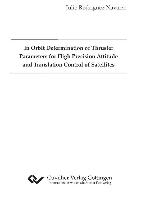- Start
- In Orbit Determination of Thruster Parameters for High Precision Attitude and Translation Control of Satellites
In Orbit Determination of Thruster Parameters for High Precision Attitude and Translation Control of Satellites
Angebote / Angebote:
New scientific space missions, which need precision pointing and/or drag-free control, are using active actuator systems for the spacecraft attitude and translation control. Such a control system requires precise actuators, which are able to generate forces and torques in the order of mN and µN. The control system performance depends on several factors. One of them is the accurate knowledge of the actuator system such as stochastic errors as well as the configuration, including alignment errors or side effects. The success of a mission depends basically on the knowledge of such an actuator system. Thrusters are arranged in a system in order to generate forces and torques in all directions and it is known as the thruster-configuration. It may vary due to extreme environmental conditions, and mechanical effects during the launch. In addition, there are uncertainties in this configuration because it can be determined only with a limited accuracy before the launch. For that reason an in-orbit calibration is needed.Estimation methods, such as least-squares or Kalman-filter, can be applied to solve the problem. However, the data used for the estimation process has many noise sources, and the satellite itself is under the influence of many disturbances resulting in errors on the estimates. To overcome such problems, methods to improve the accuracy of the estimates are proposed and evaluated in this work. Different estimation algorithms are first derived and applied to the thruster parameter estimationproblem, then they are used and compared, and some methods to improvethe accuracy of the stimates are suggested. Furthermore, the research gave the necessary information to choose the better option for the calibration in terms of estimation algorithm, control method, and type of excitation. The problems generated by the actuator system in the parameter estimation were recognized and identified. A depth discussion is carried out and a calibration procedure is proposed.For the research, a full satellite's simulator (based on theHigh Performance Satellite Simulator of the ZARM) was developed and used to generate the data needed for the estimation process. Such a model has real spacecraft values, noises and physical restrictions in order to produce a real approximation of the problem. After the best calibration method was identified, an application to a real satellite like Gravity Probe B (GP-B) was done.
Libri-Titel folgt in ca. 2 Arbeitstagen



